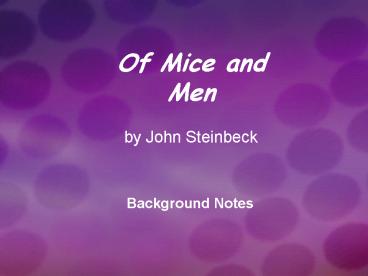Of Mice and Men by John Steinbeck - PowerPoint PPT Presentation
1 / 18
Title:
Of Mice and Men by John Steinbeck
Description:
Of Mice and Men by John Steinbeck Background Notes About the Author John Steinbeck 1902 1968 Born in Salinas, California which is the main setting/locale of ... – PowerPoint PPT presentation
Number of Views:573
Avg rating:3.0/5.0
Title: Of Mice and Men by John Steinbeck
1
Of Mice and Menby John Steinbeck
- Background Notes
2
About the Author John Steinbeck
- 1902 1968
- Born in Salinas, California which is the main
setting/locale of his writings - Took a series of jobs to find out how working
people actually lived - Liked to experiment with writing forms OMM is a
novel written within the structure of a play
3
About the Author John Steinbeck
- Favorite theme the struggle of ordinary people
- Does not romanticize limitations and defects of
people - Emphasized the courage and dignity of people who
often faced impossible odds - Awarded Nobel Prize for Literature in 1962 in
recognition of his accomplishments with The
Grapes of Wrath, Of Mice and Men, and others
4
About the Characters
- George - a farmhand who accepts temporary labor
who takes care of his friend Lennie the main
protagonist of the story - Lennie - large, strong man who has the mind of a
child the other major protagonist - Candy - an old, crippled farmhand who wants to
partner George and Lennie when they buy their own
place
5
About the Characters
- Curley - the ranch boss small, arrogant son
- Curleys wife (no name) - she tries to make
friends with Lennie - Slim - a master skinner or mule driver
- Carlson - a ranch worker
- Crooks - an African-American farmhand who keeps
to himself
6
Setting
- Set in Salinas Valley near the town of Soledad,
about 80 miles south of San Francisco - Salinas Valley contains many farms and ranches
famous for lettuce and vegetables has an annual
rodeo
7
Literary Style
- Steinbeck uses two styles alternates between
lyrical (flowery) and naturalistic (down to
earth) - Presents a slice of life, and is an allegory (a
story with an underlying moral or message and a
character who is usually plain and representative
of some abstract idea or force)
8
Literary Elements to Watch
- Conflict the struggle between opposing forces or
characters in a story - Internal within the character Man vs.
Himself - External between two forces Man vs. Man,
vs. Nature, etc. - Contrast person, place, event, etc. that shows
sharp differences when compared with another - Foreshadowing the use of hints and clues to
suggest what will happen later in the plot
9
Literary Elements to Watch
- Symbolism a person, place, thing, or event that
has meaning in itself, but that also stands for
something more than itself - Theme the insight about human life that is
revealed in a literary work American Dream
10
Symbols
- Rabbits
- Old dog
- Dead mouse/ dead puppy
- Curley/ Curleys wife
11
Themes Topics to Consider
- Loneliness
- Hopes and Dreams
- Dignity and Pride
- The American Dream
- Sense of Morality
12
Allusion
- Reference to Robert Burns poem To a Mouse which
includes the line The best laid schemes o mice
an men/ Gang aft agley. - Translated into modern English, the verse reads
The best laid plans of mice and men often go
awry.
13
Tragedy
- The impossibility of triumph for the main
characters, George and Lennie
14
The Depression
- The Great Depression is complicated
- Longest and most severe economic downturn in
American history - Began the stock market crash of 1929
- Ended with the American involvement in World War
II
15
The Depression
- High unemployment (up to 1/3 of the population)
- Nearly half of the commercial banks of the United
States failed during the Depression. - Crop prices fell by over fifty percent.
- People went hungry because so much food was
produced that production became unprofitable. - Others were unemployed because they had produced
more than could be sold.
Photograph of an 18-Year Old Mother from Oklahoma
During the Great Depression
16
The Depression
- Tens of thousands of migrant farm workers
traveled the nation looking for employment. - Homelessness, poverty and general despair
characterized much of the nation.
Photograph of a Mother of Seven Children During
the Great Depression
17
Migrant Workers
- Growers couldn't sell their fruit they left
their orchards. - People were pulled out of high school and sent to
work picking apples for three and a half cents a
box. - Despite the hard times and the low wages, there
was no trouble finding plenty of hands at harvest
time. - A combination of factors, from mechanization to
drought, dust storms, and a depressed economy,
had driven families westward to seek employment.
18
Photograph of a Migrant Worker on a California
Highway During the Great Depression






























